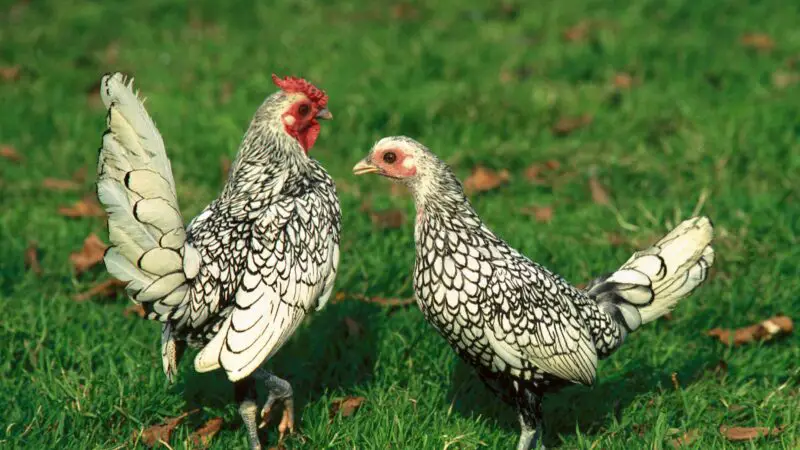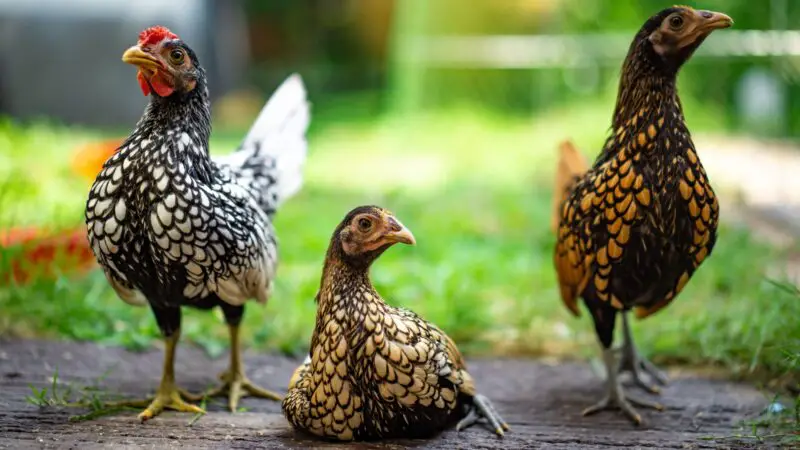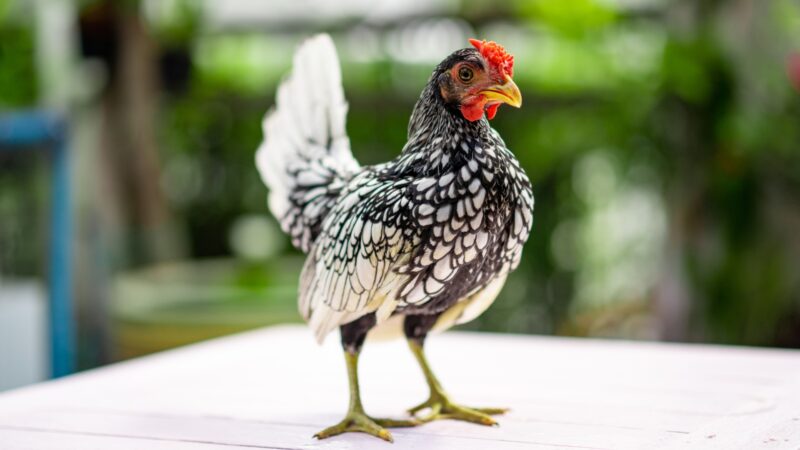Starting a poultry farm using chickens is a rewarding and profitable learning experience. You must choose the right breed for you to kickstart your chicken breeding career. An interesting breed would be the Sebright chicken, one of the oldest true bantams in the world.
Sebright chickens are small, compact-bodied bantams that are raised primarily for ornamental and exhibition purposes. They come in two color varieties: gold-laced and silver-laced.
Sebright chickens are typically 8 to 14 inches in height and 20 to 22 ounces in weight, making them relatively lighter compared to other breeds.
This article discusses everything you need to know about Sebright chickens, their history and origins, physical attributes, distinctive characteristics, temperament, and other relevant information. Keep reading for more!
Sebright Chicken History

The Sebright chicken is one of the oldest of all British true bantams or true-breeding miniature-sized chickens that are used as ornamental poultry, having been developed at the start of the 19th century by Sir John Saunders Sebright, who was the 7th Baronet of Besford, Worcestershire and a Parliament member of Herefordshire.
Sir Sebright, a gentleman farmer, wanted to produce a bantam chicken breed that was characterized by a well-defined lacing. He traveled to and from the countryside to collect birds from local poultry flocks and might have even imported birds from other poultry flocks abroad.
It took approximately 20 to 30 years of crossbreeding Rosecomb and Nankin chickens with other native bantams, as well as Polish chicken breeds before the Sebright chicken was introduced in 1810.
It is widely believed that the golden-colored Sebrights were derived from a buff Nankin bantam hen, while the silver variety was produced from a white Rosecomb cockerel.
In 1874, the American Poultry Association (APA) officially recognized both the golden- and silver-laced colorations of the Sebright as a distinct chicken breed, having passed the organization’s standard of perfection.
Are Sebright Chickens Rare?
Sebright chickens are rare. Individual chickens are hard to find, and chicks are even harder to raise because hens have poor fertility, a fact that’s attributed to two centuries of inbreeding from an extremely limited gene pool. Hence, the population of Sebright chickens is low.
Related: Are Sapphire Gem Chicken Rare | Unique and Friendly Birds
Sebright Chicken Identification
What Do Sebright Chickens Look Like?
Sebrights are short, compact-bodied chickens with prominent and convex breasts, making them resemble pigeons, short backs, full tails that are carried horizontally, and large wings that are angled downwards.
They have a deep red or mulberry-colored rose comb on their heads. Their faces, ear lobes, and rounded wattles are mulberry or bright red in color. They also have black eyes that are large and round in shape, giving them a wide-eyed facial expression.
There are two color variations for this breed: gold-laced and silver-laced. They have either a golden or silver almond-shaped plumage that is sharply edged in black, hence the “lace” pattern.
Gold-laced Sebrights have a dark horn-colored beak, while silver-laced birds have either a horn or a dark blue-colored beak. Both varieties have slate blue skin and legs.
How Long Does a Sebright Chicken Live?
On average, Sebright chickens can live for about 4 to 8 years. This is similar to backyard chickens, which live for about 3 to 7 years. Sebright hens generally have poor fertility, which consequently causes high mortality rates in chicks.
How Big Do Sebright Chickens Grow?
Sebrights can grow from 8 to 14 inches in height, which is the typical height range of most chicken bantam breeds.
Are Sebright Chickens a Heavy Breed?
Sebright chickens are not a heavy bread. They are relatively lighter compared to other breeds, weighing an average of 20 ounces for females and 22 ounces for males.
Sebright Chicken Wingspan
Information regarding the wingspan size of Sebright chickens is currently unknown.
What Is Sebright Chicken Known For?
Sebright chickens are raised primarily for ornamental use since they are neither prolific egg layers nor have outstanding quality meat compared to other breeds.
They are, however, excellent show or exhibition birds and were immediately used for such as soon as they were admitted to the standards of perfection of the APA.
Where Do Sebright Chickens Originate?
Sebright chickens originate from the United Kingdom as a result of selective breeding between Rosecomb and Nankin chickens to achieve lace-patterned plumage.
What Are the Distinct Characteristics of a Sebright Chicken?
Sebright chickens are naturally curious and active birds that like to fly into trees when it’s time for them to roost. They are susceptible to colder temperatures, as well as to Marek’s disease, which is why it’s important to place them in warm housing and get fully vaccinated.
What Do Sebright Chickens Eat?

Sebrights can eat grains, vegetables, insects, and fruits. Owners must prepare feed that is equally balanced in protein, minerals, and vitamins to ensure the overall health of their birds.
Commercially available feeds are also used, such as starter feeds, grower and developer feeds, and medicated feeds. They can also be fed a limited amount of table scraps and greens.
Sebright Chicken Temperament
Sebrights have affectionate and pleasing personality, but they are not a cuddly breed. They can be troublesome since they like to move around, are generally active, and have a penchant for curiosity.
Are Sebright Chickens Friendly?

Sebright chickens are friendly only if they are handled and coddled properly when they are young.
How to Tell Male From Female Sebright Chickens?
In terms of physical appearance, it may be difficult to set them apart since both sexes have the same color—an unusual trait in chicken breeds. However, males are characterized by having larger wattles and combs, as well as stockier, shorter legs compared to females but are slightly heavier.
The reproductive organs of males are found within the body cavity, but it is difficult to find them unless detected by professional sexers.
Are Sebright Chickens Aggressive?

Sebright chickens are not aggressive. Instead, they are somewhat skittish birds that can easily get vocal when agitated. However, there are aggressive roosters out there. It all depends on how they have been raised and the quality of their environment.
Are Sebright Chickens Good Egg Layers?
Sebright chickens are not a good egg layers. They are not known to be prolific egg layers.
How Often Do Sebright Hens Lay Eggs?
Sebright hens are known to lay about 60 to 80 cream-colored eggs annually. This number can also be affected by climate, diet, age, and other environmental conditions. They usually lay the following breeding season, regardless of when they were hatched as chicks.
Are Sebright Chickens Broody?

Sebright hens are not broody, which means that if you want to produce eggs through this breed, you would have to use a surrogate mother for incubation. As such, these birds also don’t have good maternal instincts.
Are Sebright Chickens Loud?
Sebright chickens are loud, but not as loud as other breeds. Every now and then, they scream out a high-pitched screech.
Other than that, they’re not known to be talkative or noisy, which makes them ideal pets in residential communities since you wouldn’t have to worry about them becoming a nuisance to neighbors.
How Much Is a Sebright Chicken?
As of this writing, Sebright chickens cost around $4.12 to $5.95, depending on the amount you buy. They are usually sold unsexed and as chicks.
A pair of adult Sebrights can cost anywhere around $50 to $150, based on how they were raised. Sebrights that were raised for egg production, although rare, are generally more expensive.
Sebright Chickens Care Tips
1. Housing
A clean, dry, and well-ventilated structure are all you need for chicken housing. There should be a total of three openings in the building to provide fresh air.
The floor must be concrete or dirt and is raised at least 6 inches above the ground to prevent the risk of flooding. It should also have at least 4 inches of litter such as wood shavings, peanut hulls, cane fiber, or coarse dry sawdust.
Each bird must have at least 2 square feet of space inside the house. Construct a brooder guard or circle made out of cardboard to make sure your chicks huddle near water, heat, and food sources.
2. Equipment and Facilities
There should be a sufficient water supply, usually a one-quart waterer for chicks and then a gallon-sized waterer for older chickens. The same goes for feeders. It should be simple and small-sized for chicks and larger feeders as the chicks grow.
Purchase electric heat lamps or other efficient heat sources for brooding chicks. The recommended wattage is two 125-watt bulbs per 50 chicks. Make sure the lamps are placed on the ceiling securely.
Provide adequate lighting for broilers, specifically those that can last through the night since broilers grow better under 24 hours of lighting (both natural and artificial). Suspend a 40-watt light bulb above the broilers after the removal of heat lamps.
3. Feeding and Water
Chicks should be fed a high-protein starter feed for the first 7 to 14 days, then switch to a broiler starter feed which contains about 24 to 26% protein for the succeeding 2 to 3 weeks, and finally, a broiler finisher with 21 to 23 percent protein for the remaining period. Encourage all birds to eat at the same time.
Make sure that the water is regularly replaced with a fresh and clean one. When sanitizing waterers, use a solution with 10 percent bleach.
4. Health
If you’re growing other types of poultry, keep them away from your broilers and roasters. Avoid giving medication unless the birds themselves are stressed or sick.
Most medicine would require a veterinarian’s prescription anyway. Chicks that were purchased from around May to early November should be vaccinated for fowl pox once they reach 14 days old.
Clean their living area regularly to reduce the emergence of pests and diseases that may cause problems for your chickens. You may need to deworm them if they are positive for intestinal worms. However, this is seldom a problem.
5. Culling
This process is necessary if you’re raising Sebrights for show. Remove birds that are small, stunted, sick, crippled, or deformed to improve flock performance. Reducing flock size is also necessary when all your chicks are 4 weeks old.
You would also have to maintain them by trimming nails to prevent carcass damage and making them wear leg bands for convenient identification.
List of Sources
Origin and History of the Chicken
How to Produce Broilers and Roasters for Show
